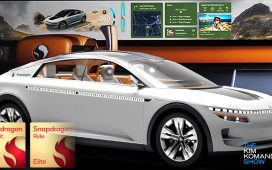Screenshot from AAA video during testing of automatic braking systems at various speeds.
They’re getting better, but still not perfect, especially in older vehicles. That’s the findings of new report on the effectiveness of automatic emergency braking systems released by the AAA Thursday.
Known as AEB, the systems use forward-facing cameras and other sensors to trigger mechanisms to automatically apply a vehicle’s brakes when they sense an impending collision.
The study compared the effectiveness of AEB systems in model year 2017-2018 vehicles to their model year 2024 counterparts. The differences were stark, yet encouraging.
Working with the Automobile Club of Southern California’s Automotive Research Center on a closed-course, each vehicle’s AEB was tested at 12, 25 and 35 miles per hour to see how the automatic braking systems reacted in preventing rear-end collisions.
The video below shows each of the tests.
AEB on the older models avoided collisions only 51% of the time while the systems on the 2024 model vehicles prevented a collision 100% of the time, regardless of speed—a finding Greg Brannon, director of automotive research at AAA said shows encouraging progress in AEB development.
“There have been advancements in the in the sensors, the number of sensors used and the sensor fusion that brings together things like camera and radar and other technologies together,” Brannon said in an interview. “But I think more importantly, the automakers have really worked on the algorithms behind that in terms of what they’re doing with that sensor information and they’re making better choices, and they’re making the hard choices, and doing it pretty well.”
AAA graphic showing how AEB systems performed at three different speeds in model year 2017-2018 … [+]
Encouraging, yes, but according to data from the Federal Highway Administration a majority of total miles driven in the U.S. are at speeds above 35 mph. That’s why the AAA ran additional tests to see how current AEB systems would perform at higher speeds.
What the higher speed tests revealed were the limitations that remain in today’s AEB systems.
Three out of four vehicles evaluated by the AAA avoided a 45 mph collision. For those vehicles that avoided a collision at 45 mph, the test speed was increased to 55 mph. At that higher speed none of the remaining test vehicles avoided a collision.
That could be problematic as the National Highway Traffic Safety Administration earlier this year issued a ruling requiring new vehicles to avoid a forward collision at speeds up to 62 mph by 2029.
But Brannon points out the 62 mph requirement is a combination of the brake being activated by the driver, or in the case of testing, robot, and the automatic emergency braking. So the fully automatic braking and the new standard tops out at 50 miles an hour.
While most of the vehicles the AAA tested did stop when traveling 45 mph, Brannon pointed to what more needs to be done to improve AEB systems to fully meet the 2029 standards.
“That work is going to be balancing the effectiveness of the systems, with the number of times that the systems give a false positive meaning that they’ve seen something and there wasn’t actually anything there that they needed to react to. That’s the most challenging aspect of all of this, and something that the engineers that are working on these systems have to continue to struggle with,” he said.
While AEB systems are improving, the AAA stresses motorists should not rely solely on the technology to prevent collisions and offer the following guidelines:
· Never rely solely on technology to apply the brakes. AEB systems are not a replacement for an attentive driver.
· Be aware of the limitations of an AEB system and stay engaged while driving. Maintain focus, even when driving vehicles equipped with advanced safety features.
· Engaging in risky driving behaviors such as speeding, texting, driving while drowsy or distracted, or driving under the influence of cannabis or alcohol significantly increases the risk of a collision. Remember to stay alert! Follow speed limits, keep your smartphone out of reach, and only drive when sober.
Brannon offers this final admonition about dependence on AEB to drivers, “It may help reduce the severity of, or in some cases, prevent a collision, but it’s certainly not meant to drive the car by itself.”







